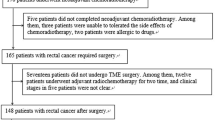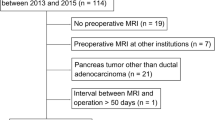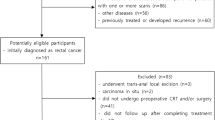Abstract
Purpose
To explore the capability of algorithms to build multivariate models integrating morphological and texture features derived from preoperative T2-weighted magnetic resonance (MR) images of gastric cancer (GC) to evaluate tumor- (T), node- (N), and metastasis- (M) stages.
Methods
A total of 80 patients at our hospital who underwent abdominal MR imaging and were diagnosed with GC from December 2011 to November 2016 were retrospectively included. Texture features were calculated using T2-weighted images with a manual region of interest. Morphological characteristics were also evaluated. Classifiers and regression analyses were used to build multivariate models. Receiver operating characteristic (ROC) curve analysis was performed to assess diagnostic efficacy.
Results
There were 8, 10, and 3 texture parameters that showed significant differences in GCs at different overall (I–II vs. III–IV), T (1–2 vs. 3–4), and N (− vs. +) stages (all p < 0.05), respectively. Mild thickening was more common in stages I–II, T1–2, and N− GCs (all p < 0.05). An irregular outer contour was more commonly observed in stages III–IV (p = 0.001) and T3–4 (p = 0.001) GCs. T3–4 and N+ GCs tended to be thickening type lesions (p = 0.005 and 0.032, respectively). The multivariate models using the naive bayes algorithm showed the highest diagnostic efficacy in predicting T and N stages (area under the ROC curves [AUC] = 0.900 and 0.863, respectively), and the model based on regression analysis had the best predictive performance in overall staging (AUC = 0.839).
Conclusion
Multivariate models combining morphological characteristics with texture parameters based on machine learning algorithms were able to improve diagnostic efficacy in predicting the overall, T, and N stages of GCs.



Similar content being viewed by others
Data availability
Data are available upon request to the corresponding author.
References
Coccolini F, Montori G, Ceresoli M, et al. Advanced gastric cancer: what we know and what we still have to learn. World Journal of Gastroenterology 2016;22(03):1139-1159.
Freddie B, Jacques F, Isabelle S, L SR, A TL, Ahmedin J. Global cancer statistics 2018: GLOBOCAN estimates of incidence and mortality worldwide for 36 cancers in 185 countries. CA: a cancer journal for clinicians 2018;68(6).
Cheong O, Oh ST, Kim BS, et al. Large metastatic lymph node size, especially more than 2 cm: independent predictor of poor prognosis in node-positive gastric carcinoma. World J Surg 2008;32(2):262-266.
Marchet A, Mocellin S, Ambrosi A, et al. The prognostic value of N-ratio in patients with gastric cancer: validation in a large, multicenter series. Eur J Surg Oncol 2008;34(2):159-165.
Chongqing T, Liubao P, Xiaohui Z, et al. Cost-utility analysis of the newly recommended adjuvant chemotherapy for resectable gastric cancer patients in the 2011 Chinese National Comprehensive Cancer Network (NCCN) Clinical Practice Guidelines in Oncology: Gastric Cancer. Pharmacoeconomics 2014;32(3):235-243.
Röcken C, Behrens HM. Validating the prognostic and discriminating value of the TNM-classification for gastric cancer - a critical appraisal. Eur J Cancer 2015;51(5):577-586.
Wang FH, Shen L, Li J, et al. The Chinese Society of Clinical Oncology (CSCO): clinical guidelines for the diagnosis and treatment of gastric cancer. Cancer Commun (Lond). 2019;39(1):10.
Taniguchi K, Ota M, Yamada T, et al. Staging of gastric cancer with the Clinical Stage Prediction score. World J Surg Oncol. 2019;17(1):47.
Sasako M, Sakuramoto S, Katai H, et al. Five-year outcomes of a randomized phase III trial comparing adjuvant chemotherapy with S-1 versus surgery alone in stage II or III gastric cancer. J Clin Oncol. 2011;29(33):4387-4393.
Lee IS, Park YS, Lee JH, et al. Pathologic discordance of differentiation between endoscopic biopsy and postoperative specimen in mucosal gastric adenocarcinomas. Ann Surg Oncol 2013;20(13):4231-4237.
Ajani JA, D’Amico TA, Almhanna K, Bentrem DJ, Chao J, Das P et al. National Comprehensive Cancer Network. NCCN Clinical Practice Guidelines in Oncology. Gastric Cancer, Version 1.2019. Available at: https://www.nccn.org/professionals/physician_gls/PDF/gastric.pdf. Accessed 14 May 2019.
Fairweather M, Jajoo K, Sainani N, Bertagnolli MM, Wang J. Accuracy of EUS and CT imaging in preoperative gastric cancer staging. J Surg Oncol. 2015;111(8):1016-1020.
Liu S, He J, Guan W, et al. Preoperative T staging of gastric cancer: comparison of diffusion- and T2-weighted magnetic resonance imaging. J Comput Assist Tomogr. 2014;38(4):544-550.
Du M, Chen L, Cheng Y, et al. Tumor Budding and Other Risk Factors of Lymph Node Metastasis in Submucosal Early Gastric Carcinoma: A Multicenter Clinicopathologic Study in 621 Radical Gastrectomies of Chinese Patients. Am J Surg Pathol 2019;43(8):1074-1082.
Fujii M, Egashira Y, Akutagawa H, et al. Pathological factors related to lymph node metastasis of submucosally invasive gastric cancer: criteria for additional gastrectomy after endoscopic resection. Gastric Cancer 2013;16(4):521-530.
Zhang CD, Ning FL, Zeng XT, Dai DQ. Lymphovascular invasion as a predictor for lymph node metastasis and a prognostic factor in gastric cancer patients under 70 years of age: A retrospective analysis. Int J Surg 2018;53:214-220.
Xiao Y, Zhang B, Wu Y. Prognostic analysis and liver metastases relevant factors after gastric and hepatic surgical treatment in gastric cancer patients with metachronous liver metastases: a population-based study. Ir J Med Sci 2019;188(2):415-424.
Gillies RJ, Kinahan PE, Hricak H. Radiomics: Images Are More than Pictures, They Are Data. Radiology 2016;278(2):563-577.
Fujima N, Homma A, Harada T, et al. The utility of MRI histogram and texture analysis for the prediction of histological diagnosis in head and neck malignancies. Cancer Imaging 2019;19(1):5.
De Paepe KN, De Keyzer F, Wolter P, et al. Improving lymph node characterization in staging malignant lymphoma using first-order ADC texture analysis from whole-body diffusion-weighted MRI. J Magn Reson Imaging 218;48(4):897-906.
Ahn SJ, Kim JH, Park SJ, Kim ST, Han JK. Hepatocellular carcinoma: preoperative gadoxetic acid-enhanced MR imaging can predict early recurrence after curative resection using image features and texture analysis. Abdom Radiol (NY) 2019;44(2):539-548.
Lakhman Y, Veeraraghavan H, Chaim J, et al. Differentiation of Uterine Leiomyosarcoma from Atypical Leiomyoma: Diagnostic Accuracy of Qualitative MR Imaging Features and Feasibility of Texture Analysis. Eur Radiol 2017;27(7):2903-2915.
Goyal A, Razik A, Kandasamy D, et al. Role of MR texture analysis in histological subtyping and grading of renal cell carcinoma: a preliminary study. Abdom Radiol (NY) 2019;44(10):3336-3349.
Meyer HJ, Renatus K, Höhn AK, et al. Texture analysis parameters derived from T1-and T2-weighted magnetic resonance images can reflect Ki67 index in soft tissue sarcoma. Surg Oncol 2019;30:92-97.
Chhabra A, Ashikyan O, Slepicka C, et al. Conventional MR and diffusion-weighted imaging of musculoskeletal soft tissue malignancy: correlation with histologic grading. Eur Radiol 2019;29(8):4485-4494.
Wang HQ, Yang C, Zeng MS, et al. Magnetic resonance texture analysis for the identification of cytokeratin 19-positive hepatocellular carcinoma. Eur J Radiol 2019;117:164-170.
Vendrami CL, Velichko YS, Miller FH, et al. Differentiation of Papillary Renal Cell Carcinoma Subtypes on MRI: Qualitative and Texture Analysis. AJR Am J Roentgenol 2018;211(6):1234-1245.
Feng Z, Rong P, Cao P, et al. Machine learning-based quantitative texture analysis of CT images of small renal masses: Differentiation of angiomyolipoma without visible fat from renal cell carcinoma. Eur Radiol 2018;28(4):1625-1633.
Kickingereder P, Bonekamp D, Nowosielski M, et al. Radiogenomics of Glioblastoma: Machine Learning-based Classification of Molecular Characteristics by Using Multiparametric and Multiregional MR Imaging Features. Radiology 2016;281(3):907-918.
Kim HJ, Kim AY, Oh ST, et al. Gastric cancer staging at multi-detector row CT gastrography: comparison of transverse and volumetric CT scanning. Radiology. 2005;236(3):879-885.
Young JJ, Pahwa A, Patel M, et al. Ligaments and Lymphatic Pathways in Gastric Adenocarcinoma. Radiographics. 2019;39(3):668-689.
Gao S, Cao GH, Ding P, et al. Retrospective evaluation of lymphatic and blood vessel invasion and Borrmann types in advanced proximal gastric cancer. World J Gastrointest Oncol. 2019;11(8):642-651.
Agnes A, Estrella JS, Badgwell B. The significance of a nineteenth century definition in the era of genomics: linitis plastica. World J Surg Oncol. 2017;15(1):123.
Maldonado FJ, Sheedy SP, Iyer VR, et al. Reproducible imaging features of biologically aggressive gastrointestinal stromal tumors of the small bowel. Abdom Radiol (NY). 2018;43(7):1567-1574.
You MW, Park S, Kang HJ, Lee DH. Radiologic serosal invasion sign as a new criterion of T4a gastric cancer on computed tomography: diagnostic performance and prognostic significance in patients with advanced gastric cancer. Abdom Radiol (NY). 2019;10.1007/s00261-019-02156-3.
Kim TU, Kim S, Lee JW, Lee NK, Jeon TY, Park DY. MDCT features in the differentiation of T4a gastric cancer from less-advanced gastric cancer: significance of the hyperattenuating serosa sign. Br J Radiol. 2013;86(1029):20130290.
Cattapan K, Chulroek T, Wancharoenrung D, Kordbacheh H, Harisinghani M. Can MR imaging be useful in differentiating low rectal cancer from anal cancer?. Abdom Radiol (NY). 2019;44(2):438-445.
Teama AH, Alarabawy RA, Mohamed HA, Eissa HH (2015) Role of magnetic resonance imaging in assessment of rectal neoplasms. Egypt J Radiol Nucl Med 46:833–846.
Lee SY, Ju MK, Jeon HM, et al. Regulation of Tumor Progression by Programmed Necrosis. Oxid Med Cell Longev. 2018;2018:3537471.
Li W, Jiang Z, Guan Y, et al. Whole-lesion Apparent Diffusion Coefficient First- and Second-Order Texture Features for the Characterization of Rectal Cancer Pathological Factors. J Comput Assist Tomogr 2018;42(4):642-647.
Chen YL, Li R, Chen TW, et al. Whole-tumour histogram analysis of pharmacokinetic parameters from dynamic contrast-enhanced MRI in resectable oesophageal squamous cell carcinoma can predict T-stage and regional lymph node metastasis. Eur J Radiol 2019;112:112-120.
Wang Y, Liu W, Yu Y, et al. Prediction of the Depth of Tumor Invasion in Gastric Cancer: Potential Role of CT Radiomics. Acad Radiol. 2020;27(8):1077-1084.
Fukagawa T, Katai H, Mizusawa J, et al. A prospective multi-institutional validity study to evaluate the accuracy of clinical diagnosis of pathological stage III gastric cancer (JCOG1302A). Gastric Cancer. 2018;21(1):68-73.
Lubner MG, Smith AD, Sandrasegaran K, Sahani DV, Pickhardt PJ. CT Texture Analysis: Definitions, Applications, Biologic Correlates, and Challenges. Radiographics 2017;37(5):1483-1503.
Tian Z, Chen C, Fan Y, et al. Glioblastoma and Anaplastic Astrocytoma: Differentiation Using MRI Texture Analysis. Front Oncol. 2019;9:876.
Chai R, Ma H, Xu M, et al. Differentiating axillary lymph node metastasis in invasive breast cancer patients: A comparison of radiomic signatures from multiparametric breast MR sequences. J Magn Reson Imaging. 2019;50(4):1125-1132.
Wang G, He L, Yuan C, Huang Y, Liu Z, Liang C. Pretreatment MR imaging radiomics signatures for response prediction to induction chemotherapy in patients with nasopharyngeal carcinoma. Eur J Radiol. 2018;98:100-106.
Dong F, Li Q, Xu D, et al. Differentiation between pilocytic astrocytoma and glioblastoma: a decision tree model using contrast-enhanced magnetic resonance imaging-derived quantitative radiomic features. Eur Radiol. 2019;29(8):3968-3975.
Liu Y, Zhang X, Feng N, et al. The effect of glioblastoma heterogeneity on survival stratification: a multimodal MR imaging texture analysis. Acta Radiol. 2018;59(10):1239-1246.
Forghani R, Chatterjee A, Reinhold C, et al. Head and neck squamous cell carcinoma: prediction of cervical lymph node metastasis by dual-energy CT texture analysis with machine learning. Eur Radiol 2019;29(11):6172-6181.
Funding
This study was funded by National Natural Science Foundation of China (grant Number 81601463), Jiangsu Provincial Medical Youth Talent (Grant Number QNRC2016040), and Medical Science and Technology Development Foundation, Nanjing Commission of Health (Grant Number YKK16113). The funding sources had no role in the study design, data collection, data analysis, or interpretation of the findings.
Author information
Authors and Affiliations
Corresponding author
Ethics declarations
Conflict of interest
The authors of this manuscript declare no relevant conflicts of interest, and no relationships with any companies, whose products or services may be related to the subject matter of the article.
Ethical approval
Institutional review board approval was obtained.
Informed consent
Written informed consent was waived.
Additional information
Publisher's Note
Springer Nature remains neutral with regard to jurisdictional claims in published maps and institutional affiliations.
Xiangmei Qiao and Zhengliang Li contributed equally to this manuscript.
Electronic supplementary material
Below is the link to the electronic supplementary material.
Rights and permissions
About this article
Cite this article
Qiao, X., Li, Z., Li, L. et al. Preoperative T2-weighted MR imaging texture analysis of gastric cancer: prediction of TNM stages. Abdom Radiol 46, 1487–1497 (2021). https://doi.org/10.1007/s00261-020-02802-1
Received:
Revised:
Accepted:
Published:
Issue Date:
DOI: https://doi.org/10.1007/s00261-020-02802-1




